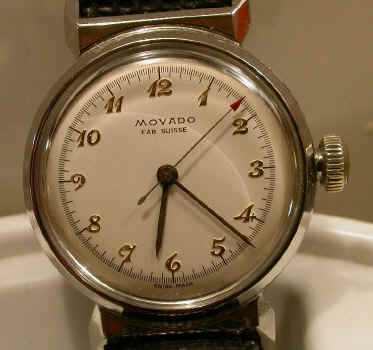
On Selecting a Watch
I am a technophile. I'm fascinated by gadgets. And since I am a
computer programmer, I keep pretty well informed about developments in
hardware. But I am a software person, and to a real software person,
that means I am software exclusive of hardware. Software is
about ideas, albeit ideas that can be realized via instructing
computers, whereas hardware is about engineering and lots of hard little
pieces. What this means is that there is a limit to the amount of
fascination I can draw from the glitz of physical devices. I started
out thinking hardware and software were all part of the same thing, and
thus anyone involved in technology had to love all of it. But they are
not really the same at all. I have taken to holding back a portion of
my personality in Luddite mode, rejecting the lure of quick comfort
through better hardware.
So how does this apply to wristwatches? As a teenager in the 70's I saw
the whole explosion of quartz and digital watches, from LEDs to LCDs to
calculator watches. I was captivated by these gadgets, and since
careful use of time is essential in school, they were indispensible as
well. On finishing school, however, and taking a step back to reflect
on the process, it occurred to me that the constant dispensation of
one's time according to the dictates of the clock was a form of mental
enslavement. Further, it was one that I could readily be freed of
because stationary clocks are plentiful enough that one's need to know
the time can be adequately fulfilled by them. So it was with some
relish that I let wristwatches go 20 years ago and never looked back.
There is no longer any risk of me being mentally oppressed any more. The
tyranny of the educational system is now far enough behind me that I no
longer even have nightmares about missing tests any more. And
ironically, I have always had a tremendous fondness for time, as part of
a general interest in all forms of measurement and organization. So
cutting myself off from time was also a test of will. How could someone
who likes watches and time so much just walk away? I think it was
symbolic to me of my ability to resist the secuction of quick comfort
gadgetry that really offers little you actually need, yet consumes a
portion of your psychic energy and focus each day, pulling you toward
the dark side. I say symbolic because a watch in and of itself is
obviously just too trivial to really do those things, but it is the only
machine that one married to oneself, cyborg style, on a constant basis.
Nowadays people are wedding themselves to more and more bits of
hardware, like cell phones, PDAs, and MP3 players. Resisting the watch
was a way of keeping civilization off my back.
But my formative years are well behind me now. I no longer have to
prove anything to myself or concern myself with symbolic gestures. In
short, I can entertain the question, do I have any use for a watch, and
if so, what use?
An example early Pulsar watch
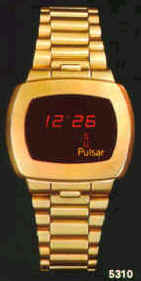
|
|
I am just old enough that my wristwatch days began with windup watches.
I had two or three inexpensive windup watches when I was 10 to 12, 1972
to 1974. I remember one was a Democratic Party watch with a donkey -- I think
it moved its leg or tail. Modern watchmaking really took off in the early
1970s. LED watches started to appear in 1972, and the LCD watches
followed a year or two later, though in mass market I remember them
coming in around 1974 to 1975. Quartz watches themselves were
introduced in the early 1970s (the first
model was on Dec 25, 1969), and even though watch batteries were
large and short-lived, of course people loved them because they
eliminated the need for winding. Self-winding watches had been
available
since 1926, but they were way out of my price range. Once one went
to quartz, it was hard to see why one would ever go back again, since
they could maintain near perfect accuracy for months on end. A
conventional watch would gain or lose seconds a day, no matter how well
made.
Consequently, I rode the technology wave in watches during the 1970s. I
went through many quartz analog watches, and all sorts of digital
watches, starting with an LED. While the LED watch craze was cool to be
a part of, it was obvious from the moment LCDs were introduced that all
LED watches would be museum
pieces within a year. The LCD used many times less power, and you
didn't have to press a button to see the time. However, until Indiglo
was introduced decades later, the lights on LCD watches were quite poor.
I much preferred the LCD and wore one with a builtin stopwatch and date,
which were pretty much standard, though the end of my watch wearing days
in 1983.
Of course, the digital watch craze was not complete until the arrival of
the calculator watch. The first
one was introduced in 1975.
|
|
Early Casio and Pulsar calculator watches
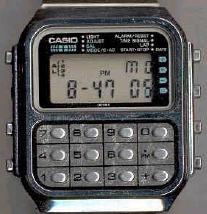
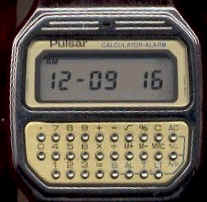
| | |
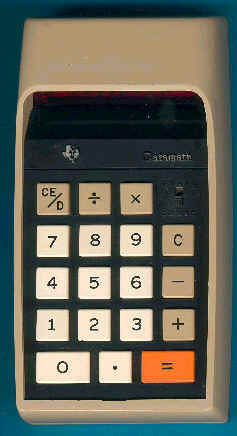
|
The first mass produced calculator:
The Texas Instruments Datamath
|
I have to digress here at the mention of calculators. One can't talk
about love of watches or technology having grown up in the 70's without
talking about calculators. Nowadays, calculators are as boring as slide
rules were back then. But when we got our first Datamath it seemed to
single-handedly lift us up out of the stone age to the computer age.
Suddenly the magic of the integrated circuit was available 24 hours a
day, always ready to perform. I calculated our average speed and
average number of miles per gallon when we took trips. We did
calculations that would result in a message if the digits were read as
letters instead of numbers, sometimes when you turned it over. And, of
course the early calculators couldn't do square roots, so I remember
computing square roots by guessing and averaging with the other factor
until it was right to 8 digits.
Naturally, when the programmable calculator was introduced in 1976 we
(my brother Bruce and I) were very keen to get one. We took a special
trip into New York City to get the TI
SR-56, as you couldn't get anything like that out in the boonies
(Vestal, New York). We pored over its thick instruction manual until we
absorbed every detail of every feature. You have to realize, we
had no idea what programming was when we started. Well, sure,
we knew it meant recording instructions and running them, but we didn't
understand at first why recording a series of keystrokes was useful --
after all, wouldn't it just get the same answer every time? The
instructions correspond exactly to the keystrokes, and you just press
the keys when in LRN mode to program it. Each instruction displayed as
a 3-character mnemonic on the screen. We finally realized that the
secret to the whole shebang was the conditional branch key, but we
couldn't figure just how it worked. Finally, it hit us like an epiphany
how branching worked, and I guess you could say it changed my life
forever, because I have been addicted to programming ever since. Because
of that instruction, a computer program can do many different things
depending on the inputs, even play "Lunar Lander", the game program TI
included. [By the way, the first programmable calculator, which got us
interested in the idea, was the HP-65,
but we were already TI fans and did not like the idea of RPN (Reverse
Polish Notation) at all. To this day, I hate it. Although HP was the
forerunner and the HP-65 is the most brilliant handheld device
ever, TI's SR series was a vast ergonomic improvement.] | | 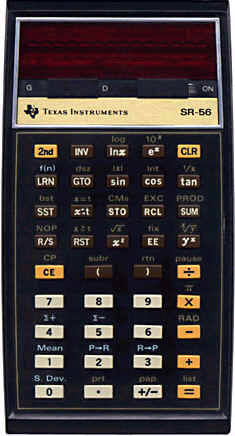 | |
Anyway, to get back to watches... if I really liked watches, and the
marking of time, why is it that in 1983 I abandoned watches (and
calculators, for that matter) for 20 years, without looking back or
having any regrets? It was really very simple. From age 13 through my
completion of college, I lived under the tyranny of time. Constantly,
throughout every day I lived and died by the clock, getting to classes
on time and meals on time and meting out every second of my day like
clockwork. Once I was out of school and I only had to show up for work
on time, my actual need for a wristwatch basically disappeared, and I
was glad to be rid of it just for the sense of freedom of being without
it. Calculators, too, while a daily part of my life while I learned and
studied math, were useless in the real world, where any math one might
want to do was more easily done with a computer anyway. The computer
was not quite so portable, but a little freedom from the box was not
such a bad thing.
Also, from a practical standpoint, there is the matter of comfort. I
recall switching to the strech metal bands (Speidel) as
soon as they became available. I would remove links until it would fit
snugly on my small wrist so that it would not shift position. If there
is one thing I can't stand, it is a watch that shifts position. After a
few years, though, I had to admit that the (temporary) welts the band
would leave in my wrist were a bit too annoying, and I switched back to
leather. I never had any interest in other metal bands, as they clearly
could not adequately deal with the shifting issue, and metal just seemed
intrinsically clunky and annoying. When I stopped wearing a watch, it
was just such a relief to be rid of it, I found the trade off more than
satisfactory.
Eventually, in the mid 1990s, my wife got me a clip watch I could attach
to my keychain. This was a protection against simply not knowing the
time in those instances were it might actually matter and no watch was
available, which could matter to her if she needed to meet me at a
particular time. I could of course ask the time from any number of
strangers, but I have never liked talking to strangers (or asking
directions). This worked well enough, but the watches would tend to
die if dropped or mishandled. I finally found a Kenneth Cole dogtag
watch about four years ago which is much more durable and has given me no
trouble.
|
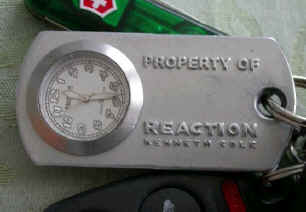
|
Ultimately, my decision to wear a watch again was quite spontaneous. We
were vacationing in St. Thomas, which happens to be the watch capital
of the world. It acquired this reputation because of its duty free
status, which theoretically allows you to get a great deal on jewelry
and watches. I would say you have to know exactly what you are buying
and what it would cost elsewhere to have any comfort that this is true,
as the prices can be quite high. Naturally, we toured around the
shops, since they were there, and having nothing better to do, I
casually looked at many of the watches.
Apparently, the spectacular initial chic of digital watches has worn
off. One could simply blame the amazing low cost at which they can be
made. You can get a full-featured digital watch for five dollars. But
more than that, the digital watch face has just never been a thing of
beauty. Never are the digits made in an appealing font, and never in
any colors but black on gray, still the only colors of LCD. Here are
some attempts to make digital watches more appealing. None of them
quite hides the fact that the basic black numerals on gray is a downer.
|

|
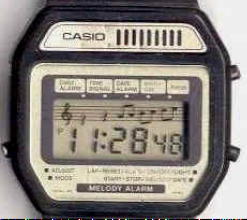
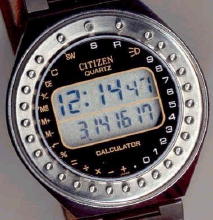
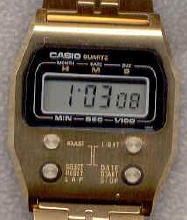
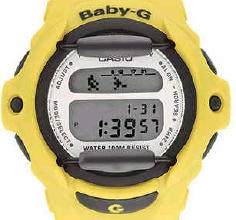
|
In fact, what one finds is that all expensive watches are analog
watches. The dial and hands can be made of any materials, e.g. those
that are esthetic. And the hands of a watch face is quicker to make
sense of at a glance than a digital readout because it is graphical.
It can give both approximate and accurate time, not just accurate time.
|
But wait. Can't an LCD display use hands instead of digits, or combine
hands with digits for the ultimate in accuracy and ease of use. As
these watches show, it is definitely possible to do this in LCD, but
the public must have realized that old-fashioned real hands were just
plain better, because watches with LCD hands were not available for
long. I think the ones shown here were only accurate to 5 minutes,
which doesn't seem good enough. The ones on the right were good to a
single minute, but don't look like hands any more.
|
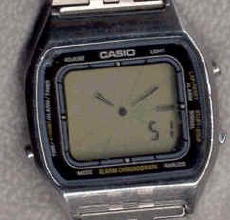
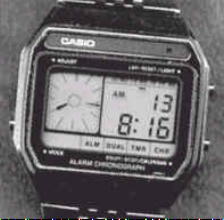
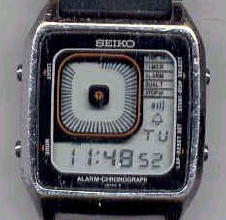
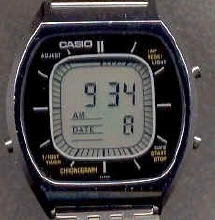
|
|
Perhaps the ultimate in combining digital with analog was this Casio
Data Bank watch, which looked like a fine analog watch on the outside,
but flipped open to reveal a hideous but functional calculator watch
inside.
|
|
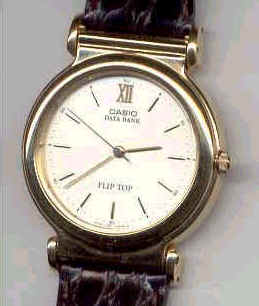
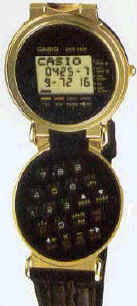
|
There is one more style of LCD watch that bears discussion -- the fully pixelated watch.
By using a fully addressable 32x16 pixel screen, one can vary the fonts and even provide
mini video games, as this $5 Timex watch does. Clearly, with higher resolution and color this design will one day
replace analog completely, but for now the technology does not appear to be there.
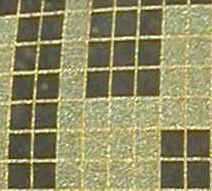
|
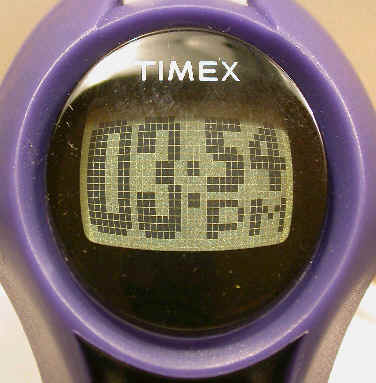
|
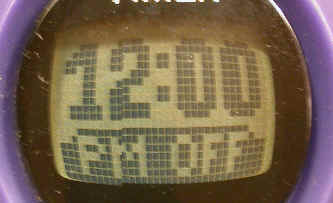
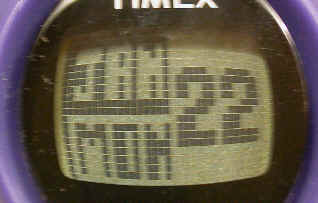
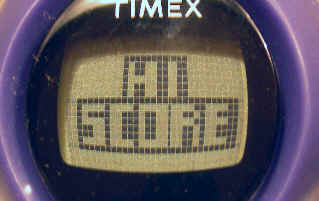
|
|
|
Mostly, though, the surviving styles of combination analog/digital
watches use real hands behind a semi-transparent LCD digital
display.
Or, a more common arrangement is to squeeze a small LCD panel behind
the analog face, such as shown here in my present day Timex Expedition.
|
|
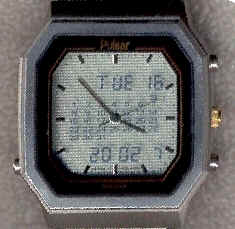
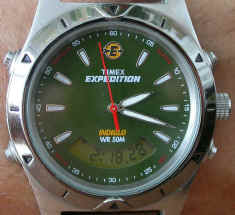
|
What it comes down to, though, is that digital watches just don't cut
it. So, having grown up to view digital as the be all and end all and
have the dream ripped apart, what really is left? Well, I do hold out
hope that the LCD stanglehold in digital will give way to full color
graphics, as it has in cell phones and digital cameras. But those are
devices where power doesn't have to last years without interruption. To
make it in a digital watch we either need much better batteries or color
LCD. So I have reluctantly forced myself to blank digital out of the
picture and consider analog watches for their merits, if in fact they
have any.
It is true analog watches have a graphical readout, and a long
tradition. The motion of hands can be a pleasing effect, and it can be
somewhat convenient to know the time at the shortest notice without
having to think much about it. By cutting out the symbolic processing
step that digital watches require, analog watches are just that much
less effort that it is pleasing. And there is the ineffable pleasure
that might come from investing one's time and energy into putting on,
taking off, and reading time from a watch as a personal expression of
one's personality. So matching the watch to the personality seems like
it could be an interesting exercise and perhaps a worthwhile experience.
So now, after all this preamble, I have set myself on the
matter of selecting the ideal analog watch for myself. The first
question one has to ask is, what do you expect a watch to give you?
Watches nowadays can do more than just tell time. Perhaps the highest
state of the art is the Tissot T Touch.
It is the only analog watch that uses the primary hands for other than
hours and minutes -- they also can act as a compass or an atmospheric
pressure indicator. Four of the other special functions (thermometer,
altimiter, chrono and alarm) just point the hands at the function name
rather than doing anything graphical with them. Overall, then the use
of the hands for other than normal hour and seconds is at best a neat
trick and not really a revolution in presentation.
So, if you are looking for multiple functions and are not terribly
impressed by gimmicks, what else can you do? The truth is, digital
watches rule in this department. I would say the Casio
Pathfinder compass watch PRG40 is typical of state of the art.
Excellent as a compass, with graphical display, and as a barometer,
altimeter, thermometer and chronograph, one has to think that if these
are the features on wants, one should just get a digital watch.
But let's face it. When do you really need to know your altitude? Who
really cares about barometers? Don't you already know the temperature?
Have you timed any sprints lately? The truth is, while these features
are cool, they are not the reason people wear watches and are really
pretty nerdy and annoying. I can't help but think if one is going to go
to the trouble of wearing a watch, it should satisfy a personal sense of
time rather than be a showcase of technological wizardry. So then,
let's dispense with the advanced features and focus more on core
features.
|
|
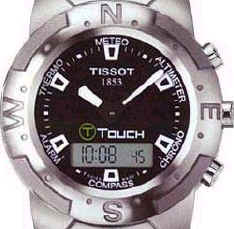
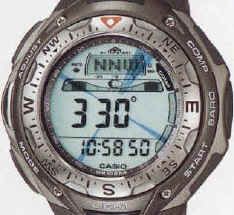
|
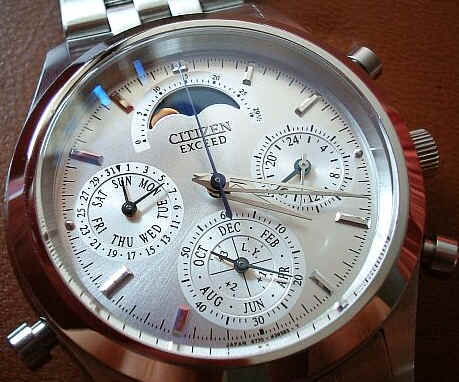
|
|
Apparently most people agree with this line of reasoning, because almost
no watches made have these advanced features. But some
advanced time features are pretty popular. Day of month is the
best known, but day of week and year also count. Many analog watches
support the day of month feature by having the day show up in a little
window. Many others have several small dials showing day of month, day
of week, power reserve (amount of energy left in a self-winding
(automatic) watch before it runs down). I think many people just like the
idea of having extra little dials and guages.
|
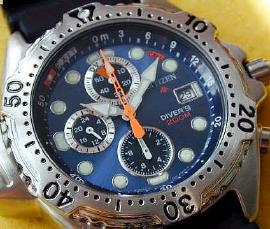
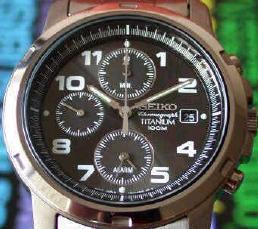
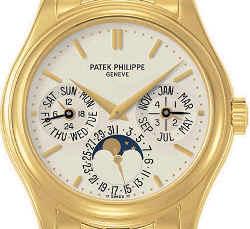
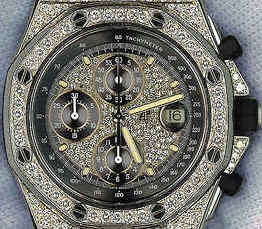
|
Quite frankly, looking at all these little dials gives me a headache.
Does even the wearer really know what they all do? I will admit than in
some, like the Patek Phillipe shown above, there can be little doubt
about their function. This watch is a masterpiece of simple elegance.
And yet, it could hardly pass as a piece of art; the little dials make
it look more like an airplane cockpit than a piece of jewelry. No,
really it is just for technophiles, and as with my above line of
reasoning, one gives up the revelation of personal style if one
embraces all this foofarah.
If one really looks at the watch face objectively, one can see that it
really is meant only to display the passage of hours, minutes and
seconds. This is the esthetic of the design, the purpose of it, and what
the space allows for without annoying crowding. If one believes the
watch should be a true expression of time, it should be allowed to
fulfill its destiny to the utmost without complication or distraction.
This is the purity argument: that
for every task there is one best way to do it which embodies the most
elegance and ease, and is thus the most satisfying and esthetic.
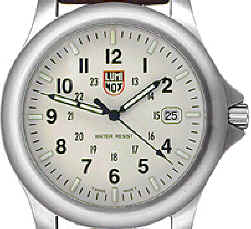
|
|
Even the little window displaying the day of the month, while arguably
being the one extra piece of information a watch might carry that is
both relevant and of some use, just can't be made to fit without
crushing the symmetry of the watch face. For instance, compare these
Luminox Swiss Army watches. In order to accommodate the date window,
the watch on the left has given up displaying 3 o'clock. Some watches
give up 6 o'clock. Few if any place the date further inside and don't
mar the outer symmetry, but then there is an extra, extraneous, digital
gauge in the middle. Really, this digital element doesn't fit in very
well on an analog watch. However useful, it just isn't any prettier than
a digital watch.
While we are on it, notice the smaller extra hours 13 to 23 that are
nearly ubiquitous on Swiss army watches. Certainly anyone can see that
this extra clutter is both ugly and of absolutely no use in the U.S.
where we never use military time. For that matter, the typeface used
for the digits, a black sans-serif bold, is very utilitarian and
unappealing. Perhaps it does speed reading a bit when you are trapped
in a foxhole, but certainly we can find something a little more
appealing?
|
|
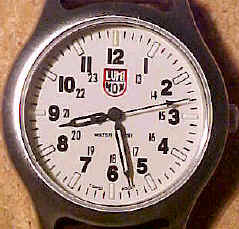
|
I just began idly thinking that it was just as well that I don't wear a
watch, because there was no way any manufacturer was going to make a
watch I would find acceptable. I based this judgment on the casual
observations I made of watches in the stores, which I find to be almost
universally ugly, and on the fact that I am fairly picky. Still, while
I was there I hit on the idea of seeing if there were any watches made
that I could actually find to be esthetically pleasing, even though I
was not really interested in having one. I guess I had probably vaguely
toyed with the idea once or twice over the years that it might not be
so bad to have a watch for certain occasions or just for the sake of
having one if I could find one that I liked. But each time I had done
this glancing at just a few models, I was disappointed. Now, looking at
hundreds of watches from most of the makers around the world, I was
equally disappointed and let the matter drop.
By now you must be wondering, how could I so completely dislike every model from every maker? Actually, I did not start out in this quest being
very picky at all. But it does not take much pickiness to reduce your choices to zero. First, the watch must have a leather strap and not a metal or
other kind of band. This simple requirement actually eliminates at least 75% of all watches. Metal bands are overwhelmingly the most popular. Second,
it must have a little line mark for all 60 minutes. I just can't be too sure of what time it is unless I have that. This actually eliminates at least of
the watches that remain. Third, it must have a second hand. I just don't see how I could like a watch that didn't appear to be moving, and that wasn't
even willing to let me know how many seconds are passing. This eliminates another 50%.
|
Now we start getting down to less critical criteria that matter
to me. I want to see all the numbers from 1 to 12. The watch face is based on the 12 numbers, and to snub any or some of them just seems arbitrary and
unfair. Still, I did consider the Charles-Hubert Paris retro watch, which only has the 6, 9 and 12,
because the numbers were large and attractive. This brings me to my next criterion: the font for the numbers has to be elegant, timeless, and clear.
You would not believe how many watches this rules out. Finding a nice font is perhaps the hardest of all my criteria. A corrolary criterion to the
1 to 12 rule is that the watch can't display the day of the month. Very nearly all watches that display day of the month do it by snubbing one of the
hours, usually 3 but sometimes 6. This really cuts into the esthetic of the watch.
|
|
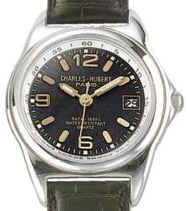
|
|
Once I had clarified the above criteria in my mind, it became clear to me that I was really only interested in the esthetic of the watch, not the
functionality. It was more important that it look good than that it keep good time. When I got back from St. Thomas, I hit on the idea of checking all
watch makes online to see if I could find one that met all my criteria. The
Invicta watch nicely matched all the criteria. But I
found it somewhat disconcerting that the digits 9 to 3 are oriented toward the center of the watch, whilee 4 to 8 face away from the center. I just
can't see any logical reason for this. It makes 3 especially appear upside down.
|
|
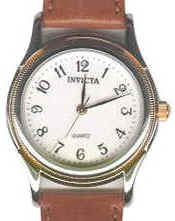
|
So then I thought perhaps a basic Swiss Army watch would do this trick, like the
Luminox
Cadet watch (shown above). It satisfies all the basic criteria, and
it has luminous hands which is convenient in the dark, and it is quartz
and indestructable, which seems nice. But, the font is not actually
attractive, it is just a bare bones utilitarian sans serif font. And
the digits are set well back from the edge, which is not esthetic. And
the 24 hour time hours 13 to 23 are shown (0 is snubbed for the Luminox
emblem), which is marginally useful but makes the watch look a bit
cluttered. Speaking of cluttered, being overly cluttered is the main
reason watches today are so hideous. Many watches are nearly impossible
to read they have so much extra junk strewn all over them. For that
matter, many men's watches have all sorts of extra outer dials which
convey absolutely nothing useful (usually seconds) and are primarily
there to make the watch seem more impressive.
|
Still, after extensive searching, these were the best I could come up with from contemporary watches. At this point, it finally occurred to me that
while taste may have gone by the wayside in today's watches, it may not always have been so. So I started searching for vintage watches on the web.
Quite a lot of watch stores have sites on the web, and there is quite a selection. And sure enough, I find the styling of the vintage watches to be
far superior, based on my criteria, to today's watches. Some of the most expensive watches made today, e.g. by
Patek Phillipe, still look a lot like vintage watches.
|
|
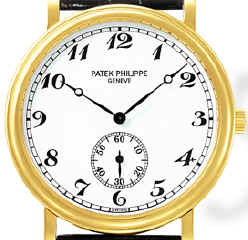
|
And as I read more
and studied more about wristwatches, it became apparent that a true watch snob will have nothing to do with quartz watches, even though they are more
accurate, because they have no respect for horology and the watchmaker's craft. Now, I am not a watch snob, but it did open my eyes to some additional
criteria. Perhaps, if one is going to go to the trouble of wearing a watch at all, putting it on, taking it off, it is not so much to ask to wind it and
occasionally reset it. In fact, being somewhat in doubt over whether it even has the right time keeps the whole issue of time and what it is all about
more at the forefront of one's mind. We are after all contemplating an investment of psychic effort, so perhaps the investment of physical effort should
be a part of that. First, I am going to invest the energy to find the one I want. That alone has cost me many hours. Perhaps it makes sense that a watch
worthy of my psychic interest should require some investment of time from me beyond being taken off at night. Perhaps a little winding introduces a human
element, symbolic of invested energy, that a purely automatic object lacks. Perhaps a watch
that is a little unreliable, a little sensitive, and a little needy is more worthy of the (albeit small) amount of psychic energy I plan to devote to it.
The whole idea is that the watch is to have some sigificance to me as an esthetic object, and as an extension of myself and my worldviews. So it should
behave like I do.
So an old fashioned windup began to seem palatable to me, which would be necessary after all if I was going to have to go that way for esthetic reasons
anyway. Now, in the windup domain one can get an "automatic" watch, i.e. a self-winding one. But, aside from bumping the price up hundreds of dollars,
which seems excessive, this feature seems to me to compromise the esthetic of the watch. Like a manual watch, it would always be running down. Unlike
a manual watch, you would never know by how much. So you would subconsciously worry about moving about enough to keep it wound, which could be an issue
for someone who sits a desk all day as I do. Or, I could invest in a little watch rocking machine, but this is even more vile. The idea here is that
the watch rocking machine lives your life for you (from the watches perspective). No, the windup was the way to go. Winding the watch is your little
reminder that time only passes if you give it permission to, that you have to invest something to get something back.
Here are some typical examples from among the more likely candidates I found. Most are way out of my price range, $1000-$4000. All lack some critical feature
I sought -- second hand, numbers, elegant numbers, etc. The oldest watches have nice numbers, but lack a second hand. Next came the smaller second hand, which
is ok, but adds an extra wheel -- not so pretty. The black Movado at the end is quite nice (though the web site selling it points out it is a knockoff) and
demonstrates how much more style Movado had than the other companies. But wait -- something has to be said about the "museum" watch that made Movado famous. I have pictured this
black monstrosity last. Yes, it has an elegance and simplicity as found in the watch whose perfection I am extolling. But this elegance has clearly been
taken too far. For one thing, a black face is just plain tacky, as with a black velvet painting. For another, the complete lack of numbers or markings of
any kind for the hours and minutes is really just annoying and pretentious.
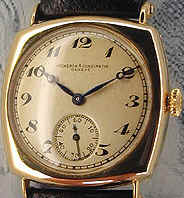
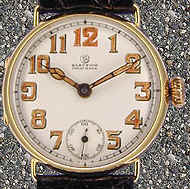
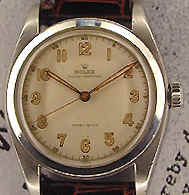
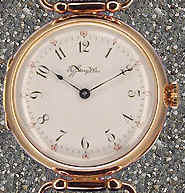
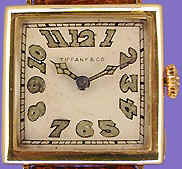
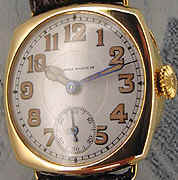
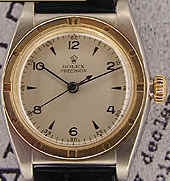
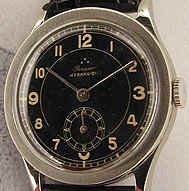
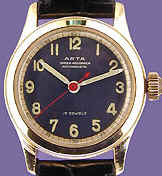
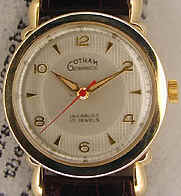
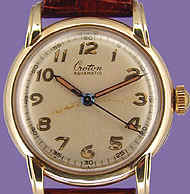
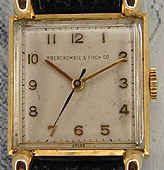
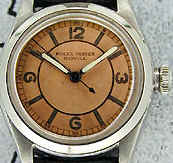
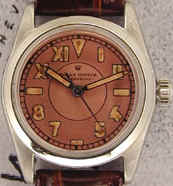
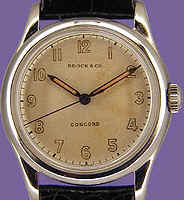
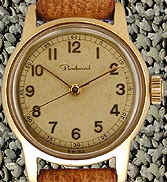
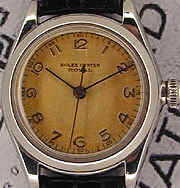
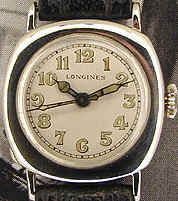
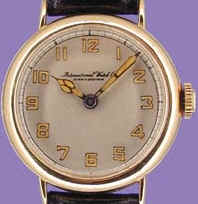
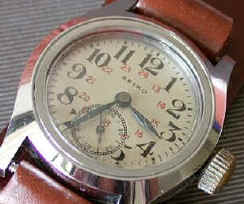
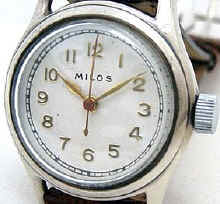
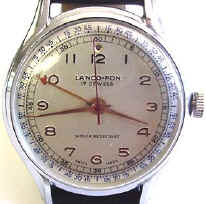
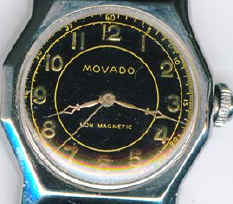
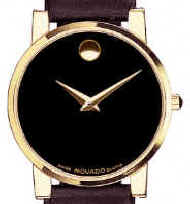
All that said it was by pure luck that I found my watch. While the vintage watches more closely matched the kind of watch I was looking for, nothing
really clicked for me over the first few hundred I looked at. I was shooting for something around $200, with a limit around $400, as this seemed about
as much as one should really throw at a fairly meaningless affectation. Most vintage watches on the web are outside this range; of course, usually only
the better ones are shown. I'm sure there are plenty of old watches not worth advertising out there. Still, I hit on the watch I bought by chance and I
have come to regard it as the perfect watch. It meets all my criteria for a watch and then some, to wit:
Features of my Movado watch
| 1. It has a nice clear mark for each of the 60 minutes, and logically with slightly larger marks for each hour.
| | 2. It has a sweep second hand. A tremendous bonus is smaller marks
for each 1/5th second, and the second hand actually ticks each 1/5th second, giving it a very smooth motion, and soft rapid ticks. Most older mechanical
stopwatches tick every 1/5th second, so it can be considered a good stopwatch. I believe that windup watches always tick 5 times a second, and quartz watches always tick once per second.
Once is just not enough; it is stilted.
| | 3. It has all the numbers from 1 to 12.
| | 4. The font for the numbers is an italic gold which is the most elegant I have seen on any watch. Completely timeless, clear, and well proportioned.
| | 5. No day of month. This nuisance feature is one more thing you have to set on non-digital watches for each non-31-day month.
| | 6. Clutter free. The watch make name "Movado" is very tastefully written in small letters, with "Fab Suisse" in smaller letters beneath.
| | 7. Colors. Black hands on a white face is the correct coloration for a watch. Anything else is trendy. My watch uses a soft cream background with
a very slight warm glow to it that looks very much like white until a pure white put next to it. A very nice improvement over decorator white. The tip of
the second hand features a dark red arrow which lends an exacting authority to the stop watch effect.
| | 8. Unreliable. It tends to lose a few seconds to a minute a day, but varies depending on how its wound. And of course it
will be way off if you forget to wind.
| | 9. Sensitive. It is not waterproof, so I have to be careful if it is going to rain or if I am going to get wet. I took it through airport security once,
and it had to be professionally demagnitized, which I figure out because it became increasingly likely to stop and finally stopped altogether, even when wound.
| 10. Slim and small! The advent of miniaturization technology has not helped men's watches at all, since modern style apparently mandates that they be huge
clunkers. If you have small wrists like me, these watches look ridiculously oversized, and they are a burden to wear. My Movado is just the right size. To put
numbers to it, the Movado is 30mm across, vs 39mm for my Timex Expedition, or 30% larger. This means the watch face is 69% larger. Quite unnecesary -- you can read
the Movado quite easily. And it is not just the face, the width has grown from 8mm to 10.5mm, 13% thicker.
And this size inflation is pretty nearly the same for all men's watches. It is quite impossible to find a modestly sized men's watch any more.
So the total volume is a full 91% more. Here is a picture
of the two faces (the time was 10:10, the usual time used to show watches, quite coincidentally -- 8:20 having been abandoned as a frown instead of a happy face):
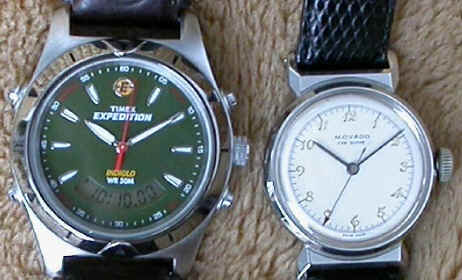
| | 11. It has a nice simple black leather strap.
| |
I find it very pleasing to look at my watch and see that it knows what time it is. It gives me a sense that the amount of time that has passed since I
last looked at it is significant, and that the time that has yet to pass will be more significant as well.
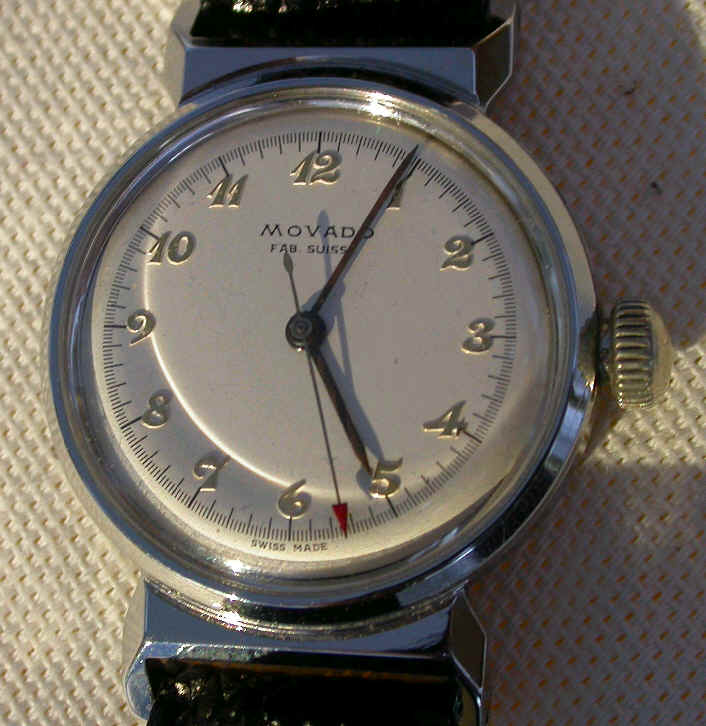
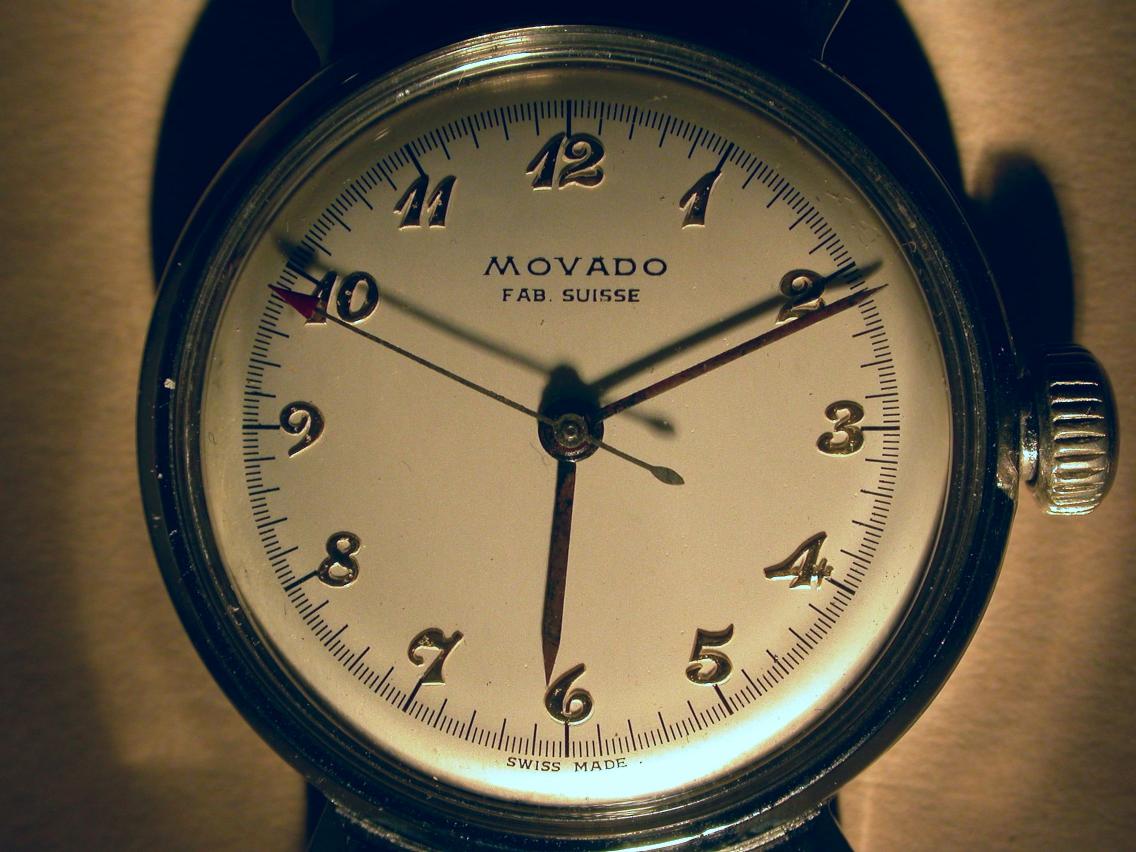
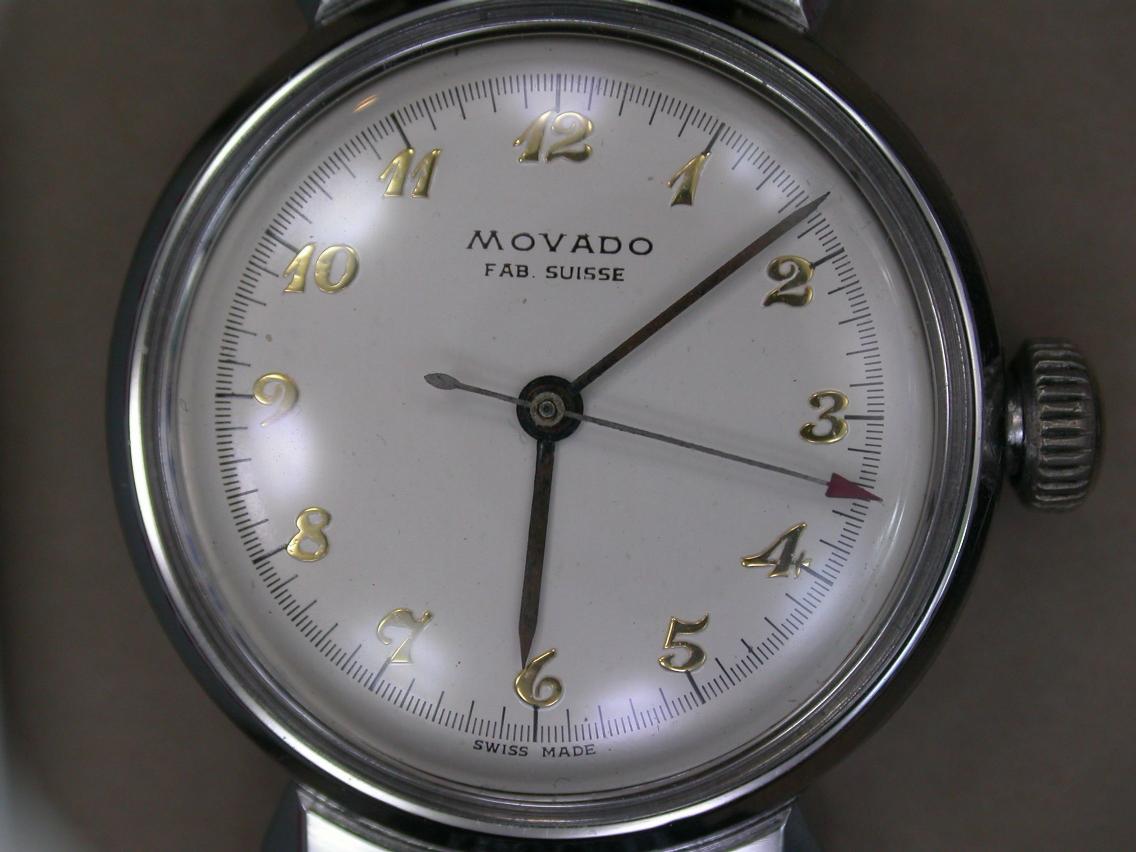
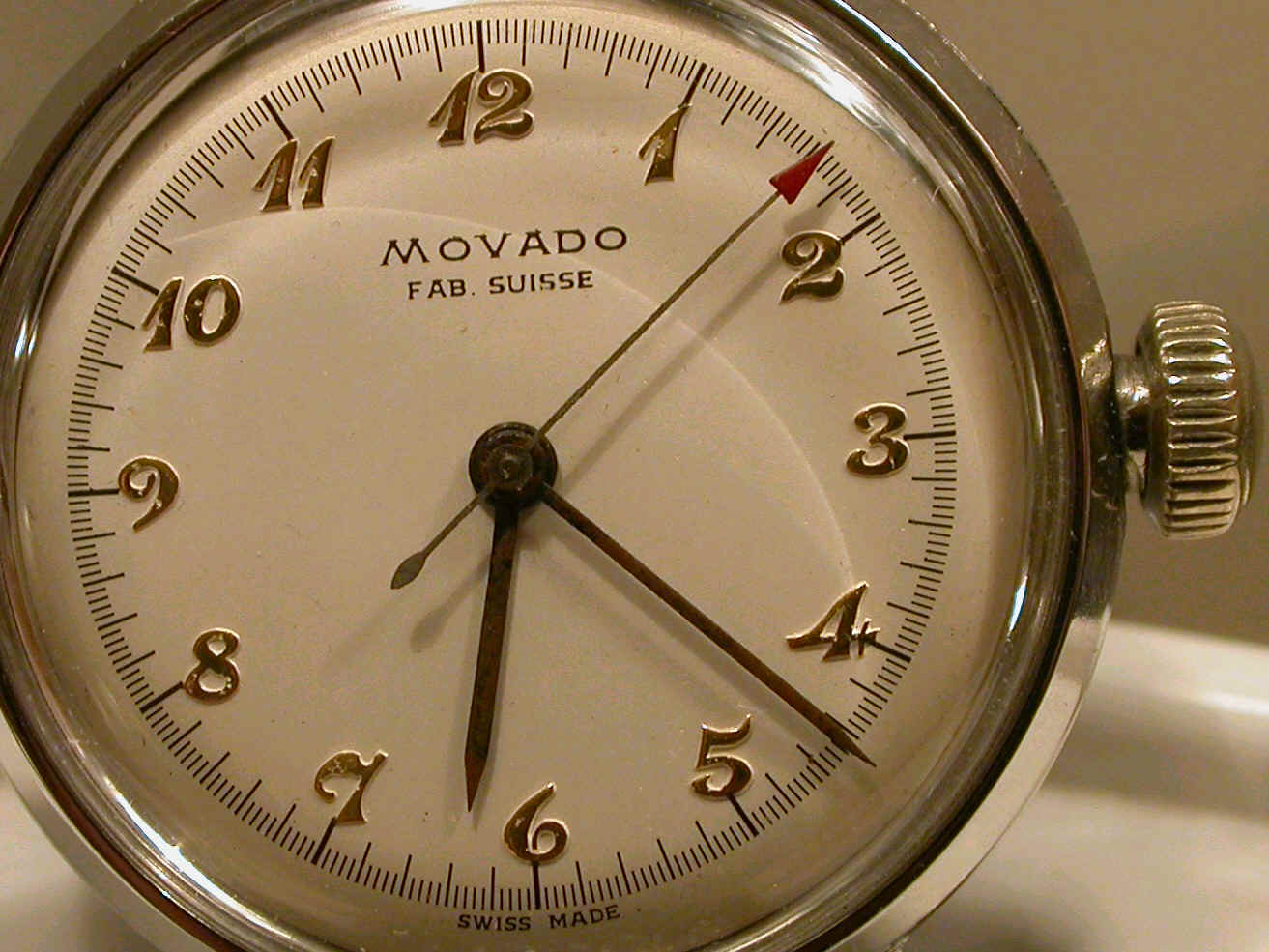
 Back to Steve's Stuff.
Steve Wagar
<steve@wagar.com>
Back to Steve's Stuff.
Steve Wagar
<steve@wagar.com>
|
Hits:
|

|
Last update: 6/26/04






























































 Back to Steve's Stuff.
Steve Wagar
<steve@wagar.com>
Back to Steve's Stuff.
Steve Wagar
<steve@wagar.com>